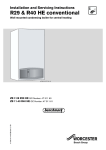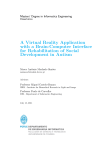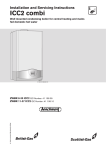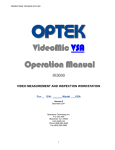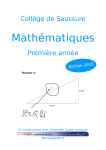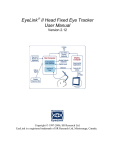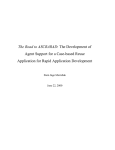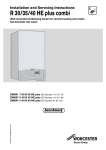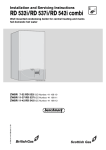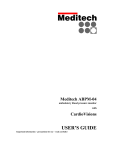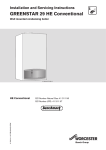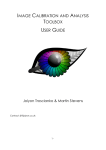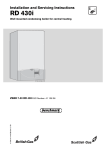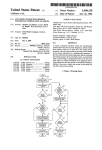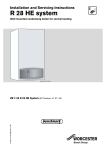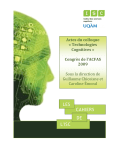Download ECVP organizers manual
Transcript
ECVP – The Missing Manual A Users’ Manual for Organizers By Tiziano Agostini, Frans Cornelissen, Kristian Donner, Jozsef Fiser, Andrei Gorea, Pascal Mamassian, Susana Martinez-‐Conde, Brian Rogers, Tom Troscianko, Andrew B. Watson ECVP – The Manual Additions By Katie Nudd, Gillian Porter, Marc Repnow, Michael Herzog, Sunčica Zdravković Purpose of this Document Each year, the responsibility for organization of ECVP passes into the hand of a new organizer. Because there is no formal society or organization behind the meeting, the organizer has been obliged to invent the meeting anew each year, with little guidance beyond what they can informally extract from previous organizers. While this method encourages novelty and creativity, it imposes a heavy burden, because there is no recipe to follow. The purpose of this document is to lighten the load on the new organizer by collecting the corporate memory of previous organizers into a written manual. Because ECVP has no formal vessel, which might contain its laws, everything in here must be considered mere suggestion. This manual may also be useful (or intimidating) to potential future organizers, and contains some suggestions for how to create a proposal to the annual business meeting. Why Organize an ECVP? It’s a challenge: allows “full” deployment of one’s organizational skills A unique experience in learning “non-‐scientific” issues Fun Promote one’s country, city or institution. Attract scientific but also political attention from international, national and local communities Past Organizers Past organizers are an invaluable resource. The official ECVP website (ecvp.org) provides a list of previous organizers, along with contact information, where known. Be advised, however, that previous organizers, having donated their pound of flesh, are sometimes reluctant to donate another. Each organizer is asked to revise and add to this document, so we hope you will find much of their wisdom and experience contained herein. Make sure you absorb its contents before you ask for help or information. Timeline This table identifies major events on the timeline leading to a meeting. Dates are given in which the year is expressed relative to the year of the meeting. In this scheme, the date of the meeting is written, Aug 25, 0. Item Start End Preliminary proposal to ECVP -‐3 Aug, -‐3 Check with City Hall if they are to be involved (ex. Banquet) Sep, -‐3 Prepare proposal 2 years ahead (select/booking venue) Jun, -‐2 Aug, -‐2 Prepare LOGO June, -‐2 Aug, -‐2 Notify organizer of intent to present at business meeting July, -‐2 Present proposal to ECVP -‐2 Aug, -‐2 Decide for the way to go for the Website and App Oct, -‐2 Contact the bank or relevant authority to initiate on-‐ line payment options Oct, -‐2 Sponsors contacted Oct, -‐2 Aug, 0 Prospecting for and choice of subcontractors (including Website arrangements) Oct, -‐2 Apr, -‐1 Contact the Rank Prize foundation, decide the speaker and contact the speaker Sep, -‐2 Mar, -‐1 Establish preliminary committee Sep, -‐2 Mar, -‐1 Prospecting for and choice (menu, price) of Banquet venue Oct, -‐2 Jun, -‐1 Prospecting for and choice of the Perception Lecturer Jul, -‐2 Jun, -‐1 Prospecting for and choice of the Invited speakers (symposia) Oct, -‐2 Aug, -‐1 Prepare presentation for the business meeting of ECVP -‐1 Oct, -‐2 Aug. -‐1 Special events decided Apr, -‐1 Jun, 0 Book Hotel space (including low cost for students...) Aug, -‐1 Launch conference website (local info, call for abstracts Oct. -‐1 and other announcements). Take over ECVP Facebook Approach Exhibitors (mail, previous ECVP, previous VSS) Aug -‐1 to Aug. 0 1st Call for abstracts Nov 1, -‐1 2nd Call for abstracts Jan 1, 0 Launch advertisements in Journals to appear in June-‐ July 0 Jan 1st 0 June 1st 0 Budget reviews Oct, -‐2 Sep, 0 Early registration Jan 1, 0 Jun 1, 0 Hotel reservation online procedure Jan 1, 0 Jul 30, 0 3rd and last call for abstracts Feb 15, 0 Abstract submission Jan 1, 0 Mar 15, 0 Choice of referees Jan. 15 0 Mar 15, 0 Review process March 15 0 April 1st 0 Deadline for financial support applications Mar 15, 0 Support requests decided Apr 15, 0 Final selection of submitted abstracts Apr 15, 0 Finalizing the invited symposia May 1, 0 Provide final Abstract selection to Pion May 1, 0 Final conference program (published on Web) Jun 15, 0 Publication of the conference abstracts in Perception Aug 1, 0 Conference proper (depending) Penultimate Sunday in August, 0 5 days later, 0 Proposal at ECVP Business Meeting Interest proposal at –3 years At the ECVP three years before your proposed meeting you are invited to make a proposal for hosting an ECVP meeting. Several things are important here: A preliminary (i.e. 3-‐years in advance) proposal is not mandatory. You don’t have to do it, and doing it will not offer you an advantage over other proposals, which may be made at the next ECVP meeting. However, ECVP attendees like to have an idea of what is likely to be happening three years down the line, and therefore you are encouraged to make a preliminary statement of interest. There will be no vote on your suggestion, since that might appear to convey a decision to approve the site. You do not need to do very much work at this stage, particularly since the meeting may never happen – the decision to approve is made at the ECVP two years before the due date. However, it would be good to know the city or place where the meeting will take place; whether it’s a city, beach location, or other location; where the lectures/posters will be held; how people can get to the location; who would be on the organizing committee; what special symposia/events you would like to organize; and any other information that might make the meeting appealing to the ECVP attendees. However, in recent year the conference has grown, making the conference organization much more demanding job, especially for non-‐professionals. Hence, both potential organizers and the ECVP community are happy to have somebody seriously committed 3 years in advance. After ECVP, you should ensure that you are able to have the meeting at your proposed venue by making a provisional booking for any space required. But try to avoid paying any deposits since, of course, there is still no certainty that the meeting will be held there. You should begin/continue to think about what symposia/events to host (both scientific and social), and who might offer financial and organizational support to you (for example, the city administration may offer financial help and/or host events such as banquets). You may put this information onto a one-‐page leaflet and bring this leaflet to the next ECVP business meeting. Nowadays this practice is somewhat abandoned and most people simply prepare a presentation for the business meeting. The organizer will give you a slot at the business meeting to make your proposal, which you should prepare as a 5-‐min Power Point or similar presentation. You should liaise with the organizer of that ECVP, to ensure that you know when and how you are presenting during the meeting. You are free to lobby on behalf of your proposal at any time, including at the meeting. Also at this stage you might rethink the option of having some professional help. It can be within the University or the Conference Center, depending how your Conference is conceived. Formal proposal at –2 years This is the time when your proposal gets voted on by the business meeting. The vote will be between your proposal and any rival bids, whether or not these have been informally suggested one year ago. Historically, ECVP has made decisions to go for a wide variety of locations – university cities, and holiday resorts in many different countries. Keeping costs down, for young people and those from poorer countries, is seen as an important issue. At least basic plans for scientific and social events are necessary at this stage. Contents of proposal /presentation: The location and dates of the suggested meeting The name of the proponent and the tentative organizing committee Your contact details The venue (address, location, map, photos) Any original ideas about the scientific and social program – symposia, banquet, art shows, etc. You should email this to the ECVP organizer ahead of the meeting, and be prepared to make a short presentation about your proposal. Votes. If there are more than two proposals, there will be (at least) two rounds of voting. The first round is intended to eliminate all but the two most preferred choices. In this round, each person at the business meeting may vote for as many proposed options as he/she wishes. Thus, it is possible to vote for Option 1 and Option 2 but not Option 3, or only Option 1, or for all (or none) of them. It is allowed to select only one of the options. This round is repeated if there is a tie that prevents the top two choices from being selected. In the final voting round (i.e. when there are only 2 choices left), people cast one vote for their preferred option. The voting procedure is administered by the local organizer, with the help of people to count the votes carefully. Report at –1 years You will be expected to present progress report at the ECVP, one year prior to the Conference. You should have all the venues booked (Conference, Perception lecture, Cocktail, Banquet, Illusion night, the Rank Prize lecture, workshops preceding the conference). Also you should have already contacted invited speakers and this is the chance to announce their names. You should announce the web site, which is to be launched immediately after current ECVP is over. You can invite people to organize symposia. You should give people some idea about transportation, accommodation and social events as well as points of interest of local culture, history and geography. VSAC Every second year, a day prior to ECVP, a satellite meeting is also organized: The Visual Science of Art Conference (VSAC). Over the last few decades there has been a growing interest in studying interactions between art and vision. An increasing number of publications (articles, books, special issues) and meetings (workshops, symposia) have encouraged researchers, scholars and students to gather together in a unitary community that can cooperate, discuss and develop new scientific perspectives in this complex and intriguing new field. The Visual Science of Art Conference (VSAC) emerged as a natural consequence of the development and maturation of this community. It was initiated by Baingio Pinna in 2012 with the aim of contributing to the scientific study of interactions between vision science and art. The first VSAC was a satellite meeting to the 36th European Conference on Visual Perception (ECVP) held in Sardinia, Italy. VSAC welcomes all kinds of work and approaches, from phenomenological to biological and computational, exploring the link between the science of perception and the visual arts. It also includes studies that might suggest new ideas and new findings useful for the experimental foundation of a Visual Science of Art. Specifically, VSAC is aimed at a deeper understanding of vision, art, and their relationship based on the observation that both visual science and visual arts (i) explore visual perception through its main properties -‐ color, spatial vision, shape, visual organization, depth and motion; (ii) analyze and create a large variety of phenomena that involve a range of objects, from the simplest possible to the most complex that involve integration across different sensory modalities; and (iii) answer different but related questions about how and why we see the way we do. This meeting is organized every even year (i.e. 2016, 2018….). Although the participants of VSAC mostly come to ECVP, they pay separate fees for this satellite meeting. Therefore the meeting generates its own revenue. It also has it’s own expenses: rooms, equipment, coffee brakes, art exhibition space, etc. It might have its own sponsors. Also business connected to ECVP (such are exhibitors of the experimental equipment) might decide to be present at the satellite meeting too. Decide early if this conference is going to be run within the same budget plan. So far this is what organizers have done. Still, it might be optimal to have another main person / small team assigned to primarily to this conference. Committee & roles There are a number of roles to be fulfilled in the organization. A rough indication is: (local) organizing committee, an advisory committee, and a scientific committee. To some extent there may be overlap and there can be extensions. Often one group does it all. Sometimes one individual does it all. Here’s an idea of the tasks and roles each of these committees may play. Local organizing committee • Makes decisions • Has financial responsibility • Does most of the actual work • Contact with conference bureau (PCO), sponsors. • Meets regularly (monthly in relatively quiet times, weekly in busier times, and perhaps even daily in the days prior to and during the conference). Ideally, the core of the organizing committee should be a relatively small group of people, 3-‐5 (an uneven number is handy to force decisions assuming you use a democratic model) with at least some actually based in the city where ECVP will be held. Consider having people with different experiences, interests, age, in your core group. An experienced administrator (e.g. from your department) may be a valuable asset in case you need to handle a lot of administration yourself. Lately, this role was often performed by a professional agency. In addition to this core, there could be people part of this who may be less frequently involved, but who you do want to give a real say in things, or who might frequently be needed to give assistance/advice. You may wish to divide the various tasks discussed in this manual to different members of the organizing committee. At the same time, it is important that important information is shared among the core group, in case of some unfortunate event that would impair a member to attend any further meetings. Another thing to think about is how financial responsibilities are shared. One model is that at least two people of the core group are required to sign any contract or financial transaction to make it valid. This depends on other factors such as how you have covered legal issues. Nowadays a lot of the financial/legal issues are simplified within the EU. However, be aware that as soon you are out of the EU, things become difficult for the organizers but also for the business in general (for example shipping the equipment for exhibitors). Advisory committee A group of people who is supportive of ECVP, and are willing to occasionally do a small task for you, give you advice, write a letter of recommendation. This group of people you generally do not want to give any decisive power. You could consider having a local advisory committee, as well as a national or even an international advisory committee. Ideally you could have one or two previous (recent) ECVP organizers on this committee. Other people to consider: dean of faculty, mayor, local science museum director/curator, politicians who have a link with science/education, head of department, high ranking people in education. Scientific committee This is in principle the group of people who will have any influence on the scientific content of the conference. It may or may not include: organizing committee, people who organize a special symposium, reviewers. Other possible committee models The 2005 meeting (A Coruña, Spain) included: a) Executive Committee (with similar roles as the Local Organizing Committee described above). It was decided to call it “Executive” and not “Local Organizing” Committee, as only 1 of its 5 members was local. b) Local Organizing Committee (with similar roles as the Advisory Committee described above). Also carried out some specific tasks, in consultation with the Exec. Committee, such as organizing specific events in the meeting. c) Scientific Committee. Call for Papers The Call for Papers should be issued by email lists ([email protected], cvnet, the ECVP list) on Nov 1, -‐1. It may/should contain the following: • Dates • Location • Deadlines • When registration will begin • Website address • Titles of symposia • Speakers at symposia • Registration Fees • Special events • Contacts (i.e. email address of organizer, secretary) Several examples of Call for Papers are given in the Appendix. Website and App Since 1999, ECVP has had its own registered domain name: ecvp.org. Andrew Watson is the current registrant of the domain, and should be contacted with any questions regarding the domain. It is important to distinguish between two distinct types of ECVP web sites. The first is what we will call the “home site,” of which there is only one, and the second is what we will call a “conference site,” of which there are many (one per year). The home site contains general information about ECVP. A conference site contains information about the meeting for a particular year. The home site includes links to the conference site for the current meeting, and where available, to past and future meetings. At present, the domain ecvp.org points to the ECVP home site. At present, Andrew Watson is the manager of the ECVP home site. There are two ways to build a conference site for your meeting. One is to create a separate, independent site, hosted on a server to which you have access. If you would like to set up a separate independent site, you would typically request the home site manager to create a link from the main site to your site, and a redirection to your site so that the url http://ecvp.org/2004/, for example, would lead to your conference site. The advantage of this approach is that you have complete control over your conference site, and you can chose a server or internet service provider that has the storage and features you desire. The disadvantages are that you must find and possibly pay for a server, and that the site is unlikely to be preserved after the meeting is over. While the home site has links to conference sites of past meetings, many of those links no longer function, as the conference sites have been dismantled. In the future, we would like to preserve at least some components of each conference site. Alternatively, you may choose to build your site on the server that hosts the ECVP home site (this was done by Kusadasi 2001, Groningen 2000, Paris 2003). To do this, you request space for your site from the home site manager. A directory is created and access is provided to you to that directory, which would typically be addressed as http://ecvp.org/2004/, for example. You would then upload files to the site via FTP (or a site-‐building application) just as you would if the server were your own. Organizers wishing to make use of hosting on the home site may need to negotiate issues such as storage and features required. Proposed Home Site Features To provide a better infrastructure for future meetings, it has been proposed that the home site includes some additional features. These may be available for use by the time of your meeting. Online Transactions Online registration, credit card payment, and abstract processing are large parts of the job of each organizer (see section below “Online Registration & Abstract Processing”). It has been proposed that these services be provided in a consistent way from year to year by the home site. This would allow the development of a persistent database of registration and abstract data, and would make the user experience consistent from year to year. Message board A message board, organized by the year of the meeting, might be useful for coordination and communication among attendees. Home site funding Costs of maintaining the home site are at present modest, but it is important to reserve some of your budget for this purpose. Typical costs are for domain registration, web hosting (circa $500 total). It has been suggested that the site be professionally redesigned and maintained, which would entail costs. Addition of online transaction processing would add substantially to the costs, but would remove that expense from the usual conference budget. Conference APP and Conference site You should synchronize the creation of your web site and the app to avoid duplicating jobs. For some time apps were available only for some type of phones but since 2014, we introduced an app that can equally well be used on all mobile devices, tablets and computers/laptops. It also allows future conferences to build upon the previous year’s ECVP app. In the future, the app might overtake many of the conference site features so it is best to conceive both things at the same time. FACEBOOK Offers you an option of communicating in a less formal way, use it as another channel to communicate info. Online Registration & Abstract Processing Since 1998, all ECVP meetings have employed some form of online registration and abstract processing. While organizers may be tempted to create an online system themselves (since 2001, every organizer has done so), there are many reasons to use an existing system. The two most important reasons are cost and effort. To do the job properly is a considerable undertaking, typically requiring much more time than expected. And the costs of doing it oneself often turn out to be higher than using existing systems that charge a fee. It may be useful to identify several separate elements of this process. However, your country might have a banking system that is incompatible with the existing on-‐line registration system. Make sure you understand these issues well in advance so that you can build your system accordingly. This also might bring the issue of the currency, exchange rates and similar. Types of online transaction Online registration Creates a user profile (name, address, etc). Individual usernames and passwords usually allow the user to re-‐enter the system at a later date to modify their profile. Registration can be completed by online credit card payments (see below). Credit card Payments Used for registration fees (and other) payments. To set up such a system is complex, requiring contracts with an internet service provider, a credit card verification service, an e-‐commerce merchant account service, and a bank. All charge for their services. Beyond monthly service fees (typical, $75/month), each transaction usually costs a fixed fee plus a percentage of the transaction, often amounting to $5 or so for a typical registration. Online abstract submission This allows authors to submit their abstracts online. It is customary at ECVP that the registration must be paid in order to submit an abstract. It is important to collect the data in a structured, record-‐based manner (in xml), so that the data can be checked upon entry and transferred straight into the publisher's template (see section below on abstract publication). This means that rather than accepting each abstract as a word file, or pdf, it should be accepted as a defined set of pieces of information, such as author last-‐ name, abstract-‐title, abstract-‐text, etc. In recent years some US institutions were unable to provide the registration payment in time but organizers were still accepting the abstract submission and later the payment. Online abstract reviewing It is very useful if the reviewers are able to do their job online. Among other things, this relieves the organizer of the responsibility for sending out abstracts for review, collecting reviews, collating the data, etc. Many reviewers also prefer not to be online while reviewing so it is nice to leave this option too: it should be possible to download abstracts. How do I get an online transaction system? There are basically four ways to obtain an online transaction system, which includes software, services, and human support. The services include internet service and credit card merchant services (see above). Support includes both technical support of the system, as well as database maintenance and dealing with users problems and special cases. • Write your own software, contract your own services, and get someone to provide support. • Use the software from a previous year, modify it to suit, contract for services, and find someone to provide support. • Contract for someone to write and support the system • Contract with someone to provide an already existing system. This is usually called an “Application Service Provider” (ASP). Option #3 is likely to be costly, take a long time to develop, and perhaps not result in the desired features. #1 is a great deal of work, and can only be considered if there is free programming talent and lots of time available. #2 can work, but is unpredictable. #4 is the best option, if it can be obtained at reasonable cost. My POC says they can do this. Should I accept their offer? Sometimes a professional conference organizer will offer to include these services as part of a complete package. Although this is tempting, there are several reasons to be cautious. The first is that, unless they have a working system that they can demonstrate, and that includes all the desired features, there is little reason to believe they can provide it in the form and schedule required. However, this is an option that has sometimes worked in the past (Budapest, 2004, Belgrade, 2014). It also helps if you are communicating with your professional conference organizer in the year prior to ECVP (as you should). In that case you can simply show them your profile for the current conference. A second reason is that the POC is inherently local, and thus changes from year to year. On the other hand it would be very desirable to have the online transaction system stay the same from year to year. If the POC does the online system, it will change from year to year. Features to look for: Whatever route you go, the following is a list of essential or highly desirable features for the online transaction processing system. Structured, database record-‐oriented data collection and storage, for both registration and abstracts Ability to edit abstracts up until deadline Ability to associate abstract authors with registrants Profiles for non-‐registrant co-‐authors Online abstract reviewing Online volunteering to review Help in assigning abstracts to reviewers (for example creating a matrix for matching abstract key words and reviewers keywords) Online access to registration data by organizers Online access to abstract data by organizers Online special event ticket purchase Online application for financial support Automatic generation of online program Automatic generation of abstract book Automatic email confirmations of all significant transactions Blast email to all registrants Online donation Online structured search of abstracts Ability to collect and coordinate data from multiple years For example, costs of redesigning the site including online transactions, abstract and review processing as well as other features (see above) were 5000 in 2003. Organizers should be aware that to such costs they should add about one full month of work supervising and interacting with the professional providers. And they should be aware that this figure does not cover the transaction costs for online credit card processing, which would amount to about 3,000 for a typical meeting. Abstract Publication ECVP abstracts have traditionally been published as a supplement to the journal Perception, published by Pion, but no longer as the printed booklet. The costs of publication are negotiated with the publisher, and in recent years have averaged about £10-‐11/abstract. In order to avoid extra work and extra costs, it is extremely important to collect and maintain the abstract data in an xml form which will be provided by the publisher. If an online abstract submission system is used, a highly valuable feature is if it collects the data in this xml format, rather than as an unstructured text document. The former is easy to convert to multiple formats, including various programs and the abstract book, while the latter is not (see section on Abstract Submission). Also take care to collect (and check) all the information that the publisher requires, since collecting these data after the fact is nearly impossible. The publisher will not copy-‐edit the abstracts. It is advisable to make arrangements with a publisher well in advance, in order to understand costs and also the required elements and the format in which the material must be provided to the publisher. You should certainly do that before you finalize your on-‐line-‐registration system. You should contact Rory Clarke ([email protected]) at Pion by the end of the previous year with details of the person who will be coordinating the tagging of the abstracts into xml. Then Rory will give them the xml template and ask that they submit a couple of trial templates (not necessarily 'real' abstracts) in advance, to check they are doing it correctly. Pion would like to start liasing with the person who will producing the xml-‐tagged abstracts by January of the Conference year, and then receive the final files by the end of May of the Conference year. The contact information for general information for ECVP at Pion is: Dr Katie Nudd Perception Managing Editor, Pion Ltd 207 Brondesbury Park, London NW2 5JN, UK e-‐mail [email protected] Tel +44 20 8459 0066 Fax +44 20 8451 6454 Web www.pion.co.uk Registration Fees Early on you will need to decide on registration fees. These are typically in four categories: early / late x researcher / student. Traditionally, ECVP has endeavored to have low registration fees. On the other hand, they must be high enough to cover the costs of venues, registration and abstract processing, audio-‐visual equipment, coffee breaks, and social events. Lately, we have introduced an Accompanying person fee. This should allow attendance of Cocktail and Coffee breaks. Usually, attendants can bring any number of people to the Banquet as tickets are sold separately. All of this is done through registration system (as well as extra needs, such as child care). Historical data. Up-‐to-‐date information may be found at ecvp.org. It goes without saying that the Conference organization will be more expensive in some locations, and that some organizers will be more successful in securing additional fund, but in general probably it makes sense not to change the fees significantly. Cancellation policy We strongly urge you to establish, before the start of registration, a clear and firm cancellation policy for registration fees. Cancellations are an administrative hassle, and typically cost money as well due to the fees involved in credit card transactions. We suggest something like the following: • Start of registration to the abstract deadline — -‐10 or about –10% • Abstract deadline to the beginning of meeting — -‐20 or about –20% • After end of meeting (yes, it happens) — no refund • Registrations for which paper is rejected — full refund. This policy should be stated clearly on the registration web page. Review process The abstract submission deadline has traditionally been on a date in the first two weeks of March (in the year of the conference). The accepted Abstracts need to be sent to Pion at the beginning of May, if they are to be published in Perception. All Abstracts need to be reviewed, preferably by two or more reviewers. Organizers may choose to ask those who have reviewed abstracts previously (lists are included on the web site/app, usually as Scientific Committee) or they may ask those who submit abstracts whether they would be willing to act as a Reviewers (Include a checkbox on the Abstract submission form). The Organizer can then select Reviewers from that list taking into account their expertise and the number of Abstracts in different areas. Reviewers need to be asked well in advance whether they are willing to review Abstracts in late March/early April (perhaps giving them an idea of the workload) and the time allowed for the review process (allow 2 weeks maximum). Reviewers also need to be asked about their area of expertise (i.e. area in which they would prefer to review). One possible way to do this would be to ask them to choose among the same key words used for the abstracts. This will enable you to match reviewers and abstracts by the registration system. If the on-‐line Abstract submission process allows (e.g. Ephesus), the Abstracts for a particular Reviewer can be made available on the Web and reviewer’s ratings entered on-‐line. Choose a simple scale and the criteria for making the ratings on a single dimension (e.g. the quality of the science) with some guidelines as to the expected average and standard deviation of the Reviewer’s ratings. Set a cut-‐off score below which Abstracts should be rejected. Traditionally, only very weak or seriously flawed Abstracts have been rejected. However a number of Abstracts would arrive in substandard English. Finally, you (and your team) can also volunteer to be reviewers previous year and learn about the process and which rating criteria to include. Decisions about which Abstracts should be for Paper or Poster presentation should firstly respect the Author’s preference for a Paper or a Poster. Second, given the popularity of requests for Paper presentations, the average Reviewer’s rating can be used to select those Abstracts chosen for Paper presentations although other factors such as the relevance of an Abstract to a proposed topic session, the inclusion of young investigators, women, and other special factors should be taken into account. It should be possible to notify authors about the acceptance of their Abstracts by the end of April but decisions about papers versus posters can be made sometime later. Organizers should aim to have the program finalized and available on the website by mid June. In assigning the abstract to sessions (especially oral) it is very helpful to preserve the authors order of chosen key words. Conference Arrangements Coffee breaks It is traditional to give 2 coffee breaks (one morning, one afternoon). Coffee + cookies, etc is a substantial expense. Some conferences venues will only allow their own coffee caterer, whereas other conference venues will be flexible. Coffee breaks can be paid for by: a) local organizers b) (if the budget is tight), attendees can pay for coffee. c) Coffee breaks can potentially be sponsored (this hasn’t been tried yet). It will very rarely happen (if ever) that 100% of attendees will be present at any one coffee break. A good number would be about 75% coffee servings of the total attendees (below 70% in the last day). Audio-‐Visual Equipment It is important to get professional service. This is not the place for saving money or experimenting. However, this is not cheap either. Find out, exactly, what minimum A-‐V requirements different conference venues include with the rental of conference rooms. Some venues will allow only their own A-‐V equipment and staff. Others will be flexible. It is possible that the local university can offer discounts if their own A-‐V equipment and staff are provided. In each room, ideally, you should have: • Video beam • Spare presentation computer/laptop • Hub to change fast from one presentation computer to the other • Adapters for different computers • Speakers connected to the presentation computer (for the Multimodal and Developmental sessions) • Laser pointer • Two wireless microphones (one for speaker, one for chair), • One or two standing microphone for questions (depending on the room size) • One technical person assisting • One backup set of everything (it can be common to the simultaneous sessions) Poster Boards Poster boards are often rented by the conference venue. It is a good idea to estimate the number that will be needed and the cost per board. Note that the cost of the board is usually the same whether you use it for 1 poster or 2 (one poster on each side of the board). ECVP traditionally uses portrait orientation of the boards. Make sure that there is enough space for each poster and around each poster. After all most of your participants will be presenting posters. Make sure that the poster space has good ventilation. It is helpful to locate coffee break near the poster space. When you notify participants about poster board size make sure to specify the height above the ground. Hotels This matter is highly dependent upon the location of the conference. On occasion, all attendees have been housed in a single hotel. More often, a variety of hotels and other accommodations are offered. Distance to the conference venue is crucial. Several options, with different price ranges, within walking distance are optimal. Some form of discounted student housing should be provided. Often, this can be negotiated with the local university (student dorms). Also offer some hostels even a camp. Nowadays short-‐term apartment rentals are probably the optimal cheaper option. Rooms need to be blocked in advance (see timeline). Make sure that the fees offered by the local organizing company (if one is used) are not higher than “street” fees. Some hotels will provide extra facilities, such as small conference rooms for the committee members, etc. Venues There are no rules regarding venues, but some suggestions may make the proposal more likely to win the votes of the attendees. If the meeting is hosted in a city, the central part of the city, close to restaurants, main attractions, etc., will be usually more attractive to voters. It is important to make sure that there is a room big enough for any plenary lectures (e.g. the Perception Lecture, which can be hosted elsewhere, if necessary/convenient/cheaper). Venues in less accessible parts of the city are possible, if they have some special attraction. The venue may cost as much as 1/5 of the budget, but may on the other hand be nearly free if provided by a university or negotiated as part of a hotel deal. The ability of attendees to travel to the meeting should also be considered. In general, the less accessible, the fewer attendees should be expected. Events ECVP has the tradition of integrating science, art, and culture, in a fun way. Social/cultural events are encouraged, and looked forward to! Some of the events (science museum, art museum exhibits) allow for connecting the meeting to the general public. Events featuring some typical flavor of the city/country hosting the meeting are usually very successful (typical dances, food, etc). You can also think of some social program for accompanying persons. This is less common, and may be left as extra cost options to the professional conference organizer (if one is used). Who pays for the social events? Typically, there is a banquet sometime during the conference. Banquet fees are paid in advance, at the time of registration, by individuals. Fees for the opening reception (there is usually one) are usually included in the registration fee. The cost of the opening reception can be paid by a sponsor, such as the City Hall. A closing reception/cocktail can also be offered, depending on budget constraints. Art and museum exhibits can be sponsored by local foundations/sponsors. Other activities are also possible, such as pre/post-‐meeting excursions, etc. In this later case, interested participants can be asked to pay a fee to cover a fraction or the whole of the costs. Some other events that have worked well in the past were: bike rides, beach parties, boat trips, theatrical and musical events. Professional organizers (PCO) In the early days, ECVP was organized by a few volunteers, but in recent years it has become more common to make use of a professional conference organizer (PCO). This may be a very useful investment. The professional organizer will typically take care of: • Facilities for setting up secretary: staff, phone, fax, networking • Processing of permits • Conference signage • Administrative management of commercial exhibits • Lodging reservations • Travel reservations • Renting and decorating conference venue • Organizing social events • Follow-‐up of printing services • Management of rental, set-‐up, and control of audiovisual equipment The PCO may also provide the services discussed below under Registration and Abstract Processing. However, these services may also be provided by an independent agency. This has the advantage that the agency need not change from year to year, while the PCO must. The PCO may also assist in construction of the local website, though this need not be done by a local agency and may benefit from consistency from year to year. This may also be done without too much effort by the organizing committee. Professional organizers are not cheap. You may pay up to 1/6 of the total budget, depending on services provided, so you should shop around and compare prices/services. Important issues to take into account when choosing your professional organizer are: • Experience with similar size/nature conferences • Experience with international conferences • English proficiency (read, written, spoken) • Good references from previous customers Helpers Some local graduate students, postdocs, etc. may help with registration, paperwork, etc., and have their conference fees waived in return. This can help cut costs. Also undergraduates (working in your lab) might be around during the conference helping attendees with various issues (from the orientation on the first day to attaching the poster on the poster board). They are usually dressed in the recognizable T-‐shirts. Sponsors Sponsors are an important element of a successful ECVP. In recent years they have typically provided about half (?) of the funding for the meeting. Typically sponsors are corporations, government agencies, and foundations. Many sponsors are local, but several are either international or have a long-‐standing relationship with ECVP. A list below provides some examples of sponsors from recent years, along with some helpful contact information. It is highly advisable to approach potential sponsors very early in the process (see timeline). Some may have time-‐consuming application processes, or may operate on particular application schedules. List This list contains sponsors who have contributed substantial amounts in the past. It omits very local sponsors who are unlikely to contribute outside their locale. Also, you can see the sponsors listed on the Conference web site and in the Abstract book. Sponsor Year Amounts Contact Notes AT&T 2001 10,000 IBRO (International Brain Research Organization) 2001 7,000 EOARD 2001 6,000 UNESCO 2001 5,000 NASA 2001 5,000 San Jose State University Foundation 2001 2,000 Kevin Jordan [email protected]. nasa.gov Alcatel 2001 1,800 Pion 2001 1,430 Dr Jonathan Briggs [email protected] Perception Lecture CRS 2001 1,000 Exhibitor Suggestions Occasionally a sponsor may be attracted by the opportunity to sponsor a special designated part of the meeting, for example a lecture, a symposium, or a social event. Exhibitors Exhibitors may be an important source of revenue. Manufacturers of eye movements trackers, dedicated visual display cards, virtual reality soft-‐ and hardware are usually ready to pay between 1500 to 3000 fees for a space of between 7 to 9 meters square. Publishers typically offer between 500 and 700 for an exhibiting space of about 6 meters square. List of exhibitors and contacts Exhibitor Address/Tel/email Email / Website Contact Arrington Research, Inc. Tel: +1 (480) 985-‐ 5810 Toll Free: 1-‐ 866-‐222-‐3937 Fax: +1 (425) 984-‐6968 [email protected] www.ArringtonResearch.com Katy, Arrington SR Research -‐ EyeLink 3206 Vance St. Osgoode Ontario, Canada K0A2W0 [email protected] Sol Simpson S. Oliver Associates c/o EYECOM EYECOM 6 rue Eugene Varlin 75010 Paris [email protected] Mr. Stephane Lachkar LC Technologies, Inc tel. 703-‐385-‐7133 9455 Silver King Court Fairfax, VA 22031 [email protected] www.eyegaze.com Nancy Cleveland Medical & Technical Coordinator WorldViz LLC 29 West Anapamu Street 101-‐ 121 Santa Barbara, CA 93101 Phone 001-‐805-‐966-‐0786 Fax 001-‐805-‐685-‐ 0401 [email protected] www.worldviz.com Matthias Pusch Cambridge Research Systems Ltd. Tel: +44 (0)1634 720707 Fax: +44 (0)1634 720719 [email protected] http://www.crsltd.com Tony Carpenter LAWRENCE ERLBAUM ASSOCIATES, INC. Margaret Onesios Barley Mow Exhibits Centre 10 Barley Coordinator Mow Passage Emily [email protected] Chiswick London W [email protected] Wilkinson 4 4 PH UK Tel: (44) Editorial http://www.erlbaum.com (0) 208 994 6477 Director Fax: (44) (0) 208 Lawrence 563 1345 Erlbaum Associates Ltd. Advertisers Although it has not been common in the past, the organizer might consider soliciting advertisers whose ads would appear in the program book, participant’s bag and possibly the web site. This is different from sponsors and exhibitors. Perception Lecture The Perception Lecture is usually the most important invited lecture of the meeting. It is usually scheduled to open the Conference and it is typically held outside of the Conference venue (in some appropriate, important, historical or cultural venue). For a number of years the publisher Pion has provided sponsorship of this lecture. In recent years the honorarium has been of about 1200 GBP. Communicate with Pion about suitable person for the perception Lecture about two years in advance. Contact the speaker immediately after and have them committed before the business meeting of the previous year. Make sure you understand what A-‐V equipment speaker needs (as there might be special requirements due to desire to present special demos, for example). Make arrangements with Pion and speaker about the money transfer. The money from the Pion should at least cover travel, accommodation and fee. The whole sum should be given to the speaker. The Perception lecturer should be encouraged to write a paper based on their talk for publication in Perception. Also, the lecture should be videoed to go onto the Pion website -‐ this could be simply with the use of a mobile phone or tablet. A good example is the 2013 talk, here: http://www.perceptionweb.com/ECVP.html. The video file should be no more than about 400MB. The list of Perception Lecturers can be found at ecvp.org. Tom Troscianko Award AVA sponsors this award since 2012. The AVA will provide up to 1000 E, and expects the organizers to match that, to give a total of 2000E, but it might well be less. Contact person for AVA is Timothy Meese <[email protected]> The timeline. The AVA committee meeting is about Oct 11th. They send out the call for submissions early in the New Year (and it would be good if that could be added to the ECVP web page at the same time -‐ Tim provides details at that stage). The applications will be judged by a sub–committee of the AVA, with a decision to be made around April. They like to get the money to the winner before the trip, but the AVA can cover that and then have ECVP reimburse their share at a later date. They need much about 5 minutes for the AVA the business meeting, to make the award and for the winner to say something very briefly. All of this should also appear on the Conference website/app. The Rank Prize Lecture Contact professor John Mollon ([email protected]) about two years in advance about the Rank Priez Lecture. Contact professor Mollon before you contact potential speakers because foundation has some specification who could be a suitable candidate of the appropriate distinction. Still, the choice of Lecturer is left to the local organizers. Professor Mollon notifies the Rank Committee of organizer’s choice at the following meeting. They try to keep the arrangements as simple as possible. The Rank Prize Funds will provide £1500 towards an honorarium for the speaker plus his travel and accommodation costs and registration. About one month before the meeting send to Prof Mollon an invoice. He will then place it in the hands of the appropriate officer and it will be paid by bank transfer. The Rank Prize Funds will provide a framed Certificate for presentation to the Lecturer. This will be presented at the business meeting. Costs and Budgets Each meeting is unique, and expenses in various categories vary widely depending on the locale, but it is essential to have some idea of the costs involved. In this section we provide a rudimentary budget template that may be useful in anticipating and enumerating your own income and expenses. We also provide an excel spreadsheet that can serve as a starting point for estimation and calculation. However, the current budgets are always presented at the business meetings and they also provide usful information. Graphic Design Professional and consistent graphic design enhances the reputation of the meeting, and thus the likelihood of sponsorship. Some items requiring graphic design are: • Logo • Website • t-‐shirt (optional) • cover of program book • cover of abstract book • stationary (optional) Some solutions that have been used in the past: a) a member of the committee provides designs b) a graphic artist is hired c) a contest is organized (see appendix for 2005 logo contest call). Publicity & Press Publicity Some means of advertising the meeting are: Mailing lists: send call for papers to [email protected] and [email protected]. These have a wide distribution, and are free. Advertising in vslist will also result in an entry in their list of conferences. ECVP’s website Advertising at other websites: www.visionscience.com, websites of sponsors (IBRO)… Advertising in journals (past experience suggests this is not very cost-‐effective) [As for ECVP 1990 & 2003, advertising in scientific journal did not cost us a penny] Meeting’s poster (at VSS, sent to individuals and institutions by regular mail). It hasn’t been done every year. It is unclear how much it helps vs. cost. Send poster to leading individuals around world, ask them to post in department. Press Coverage of meeting This is easier to accomplish if there are some public lectures/events related to the meeting (such as the art exhibit, etc). Local TV stations and newspapers can give coverage. This is attractive to local sponsors, and may increase last-‐ minute local registrations. Banking A bank account has to be opened fairly early on to handle venues booking and early generous sponsors (see Timeline section above). There are different options on where this bank account can reside: (1) University: if you are dealing with a local University, they will have a finance department that will be able to open a special bank account for you for a small fee. Alternatively, you may be able to have an account within your own department if you can use the time of your local administrator. (2) Professional Conference Organizer (PCO): if you are dealing with a PCO, they will probably be able to open a bank account for you. However, this may inflate the meeting’s budget due to VAT (since the PCO is a for-‐profit organization). (3) Any other organization: if you have contacts with a non-‐profit foundation or a local academic group, this could be an easy way to handle your finances. (4) Private Account: Some organizers have opened a new business account in the name of the organization. In order to do this, a temporary non-‐profit organization should be created (to avoid VAT). What you need to worry about when you choose your bank account: -‐ who can sign for the expenditures? -‐ can I get regular balance updates, especially in the last few months? -‐ can I get a detailed breakdown? -‐ can I access the balance online (if you want)? -‐ will the account holder be able to issue official receipts? -‐ is the account taxable, and how do I handle VAT (value added tax)? -‐ do I want to open a Euro account rather than a local currency account (if applicable)? Insurance It is a good idea to consider taking an insurance against bankruptcy. There are several levels of coverage, and each country will have its own insurance system. This is not very expensive if you only buy coverage for 6-‐12 months (about 2,000). Glasgow in particular obtained insurance. This has not been a common practice. Legal Issues ECVP Trust Liability Signing contracts Financial aid ECVP has traditionally provided financial aid to needy participants. This has enabled participation by economically disadvantaged countries. In many years this aid has taken up 1/3 of the total budget. A common plan is to require those seeking aid to apply, request a specified amount, and state the justification. Applications are typically due at the same time as abstracts. Applications are reviewed by the organizing committee and some are accepted. Applicants seeking aid may be allowed to register without paying, on the understanding that they will pay or withdraw if the application is denied. If it is approved, registration fees are usually part of the award. A common award might be free registration plus several hundred Euros for travel, meals, and accommodation. The remainder should be provided only at the meeting, to prevent bogus applications. All of this should be done through web site/app and the Registration software. Certificate of attendance The organizer should arrange to provide a certificate of attendance to those requesting it. This may be provided by some POCs, but can also be easily printed by the organizer. Visas Organizer will be asked to provide a letter of invitation (and possible other documents) to enable a participant to attend. You should organize these visa related activities in carefully and in advance. We advise conference organizers to be extremely cautious, as the requests may not be genuine and may legally entangle the organizer. Do check the rules of your country and ask for professional assistance if necessary. However, do not refuse such requests, otherwise the conference will end up systematically blocking scientist form certain regions (some of them might be your grad students with the foreign passports). Business Meeting At some point during the meeting (usually on the last or next to last day), you must schedule and chair a business meeting. This is the only opportunity to transact the annual business of the conference. Below we enumerate the main items of business, in the order they are usually conducted. Use web site to prepare agenda in advance, to invite people to contribute Schedule time for all the activities such as awards presentations (AVA award, students award, the Rank Prize Lecture) and future meetings proposals. Use web site to prepare agenda in advance such are important questions for which you need participant’s vote. Final Report At the business meeting, it is traditional that the organizer present a report on the meeting, summarizing information such as number of registrants and abstracts, what countries they came from, who helped with the meeting, budget, sponsors, plans for future meetings so far as they are known, and any parting thoughts the organizer may have. We urge each organizer to convey a copy of this report in the form of a PDF document to the ECVP general website manager, where they may be made available to future organizers or the general public. Next year The organizer of the next year’s meeting provides a very brief report on plans for the meeting. 2 yr proposals The chair asks for proposals for the year after next. The chair will usually know of these proposals in advance, and will allow each proponent to make a brief (5 min max) proposal. The chair will then conduct a vote to select the site for 2 years hence. 3 yr proposals The chair invites preliminary proposals for 3 years hence. As stated elsewhere in this document, no vote is taken on these proposals. Other business The chair may raise and ask for votes upon any other item, and may invite other members to raise items. This is an opportunity to pose questions to the attendees and to chart the future course of the meeting (though there is no organization, and hence no mechanism for enforcing any decision taken at the meeting, beyond the votes of the Business Meeting attendees. Next year organizers Last few years it has became customary to invite next year organizers to stay an additional day to meet with you. You can give them all the advice, data and files they might need. However, most helpful is to stay in touch so they can request specific help as they face specific issues. Further readings August Epple (1997). Organizing scientific meetings. Cambridge University Press. FAQ How can I make use of the general ECVP website? Contact Beau Watson: [email protected] How do I find sponsors? Sponsors are often connected to the country in which ECVP is organized. Inquire locally. Exceptions are US Airforce, and EC. Previous years organizers might also give you leftover money. There’s no formal ECVP organization. I need one to get money, support etc. Despite many attempts, the ECVP business meeting attendees tend very much against setting up a permanent organization. Very often legal matters can be solved by establishing a local non-‐profit body/organization with legal standing just for the ECVP you are organizing. That's how it was done in Groningen. It removes direct legal risks and consequences from the organizers themselves. Who can help me organize an ECVP? No one, in principle. As there’s no formal organization, you are on your own. This is both good and bad. Future organizers should be aware that organizing a meeting will cost time, whatever support others provide. There's simply too many local factors that affect each organization differently. I want to organize an ECVP in 20XX. How can I get it? Make a proposal and present it at the next ECVP business meeting. How do I decide who has to be included in the organizing committee? The role of the organizing committee is to help you in all the aspects of ECVP organization, therefore, you have to select a group of people that can cover all the different needs, ranging from very practical and manual tasks to public image and relationships. How do I decide who has to be included in the scientific committee? The role of the scientific committee is to help you in organizing the scientific aspects of the Conference (organizing symposia, selecting paper/posters, editing and improving abstracts, etc.). The different local organizers of the past ECVP used different criteria to select the scientific committee; for example, in Trieste, first the abstracts were divided by main topics and then one expert for each one of these topics was named the action editor for the evaluation process.They, together with local organizers and symposia organizers, formed the scientific committee. In particular, they had to send each abstract to at least two referees and then to send back an evaluation about the global quality and the suitability for paper/poster presentation. Is there any suggested rejection rate? As low as possible. The ECVP philosophy is to encourage scientific exchange among young researchers and to offer an opportunity to eastern countries’ scientists to present their own work. How do I choose social events? Since one of the ECVP main purposes is to promote cultural exchanges, try to address your choices on seasonal and traditional events of your area. How do I choose the banquet? Try to choose local customary foods and beverages, in a special and lovely location, affordable to everybody. Specific advises Web site We created the website from scratch, using PHP/MySQL on a dedicated server running Apache under Linux. Online credit card payment was handled by another server, which was administered by our school (online payment should work pretty similarly with any provider). We didn't use a content management system (CMS), because there was not too much to manage. However, considerable time had to be spent to create HTML code which made the website look similar with different browsers. For that reason, it actually is a good idea to get the HTML code for the website layout created by some CMS or alike. Personal note: Why not outsourcing the project or, at least, using a conference management software? This is a valid question, and I guess both, outsourcing or using a software, can be more efficient than doing it from scratch. But what if the company (or just the responsible programmer at that company) is incapable, or if the conference management system you have picked turns out to be insufficient? Then you end up having paid quite some money and still having spent lots of unpleasant time to get the work done, not speaking of the time you might have spent for finding out which company or the software package might be the best. Of course, the decision also depends on your skills. I usually write programs for stimulus presentation or data analysis for Windows PC's, using C/C++ or MATLAB. Over the years, I have also set up one or the other Linux system and a few simple websites, some of which included basic PHP programming. But I am far from being an IT nerd, had never used MySQL or any other database before, and my PHP programming skills were medium at best. But having to learn these things was actually a motivation for doing it myself. I was afraid of two things though, the hardware and the online payment system. The hardware, however, is not a real issue anymore nowadays, although any system can be slowed down by bad programming, but not much data has to be moved and the number of users interacting with the system at one point in time is well manageable. And the online payment turned out to be no problem at all, because all the security relevant stuff is handled by an external provider anyway. What I did underestimate, though, was the incompatibilities between browsers and the amount of script code finally needed to cover all the tasks along the registration, abstract submission, reviewing, and publication process. All in all, it was a lot of work, but unless I don't have the direct comparison with either of the alternatives, I cannot tell whether going for the alternatives would have caused less work or, my guess, less pleasant work at the least. Key Words Choose key words carefully. You will need them to match abstracts to its reviewer and later to assign them to correct talk/poster session. It might help to have a hierarchy or order of chosen key words (so you know if author consider the abstract as an eye-‐movement study that happens to deal with colour or a colour study that happens to use eye-‐tracking methodology). Option 1 3D Vision, Depth Contours Multistability, Rivalry Adaptation, Aftereffects Contrast Natural images Ageing Crowding Objects Perception and Applied vision Emotions, Cognition action Art and vision Eye movements Perceptual learning Attention Face perception Perceptual organization Biological motion Haptics Reading Brightness, Lightness Imaging (fMRI, EEG, TMS) Scene perception Clinical vision Illusions Learning and Spatial vision Colour memory Temporal processing Computer and Robot Models and theory Texture vision Motion Visual search Consciousness Multisensory processing Option 2 Key Words Topics (no less than 2 and not more than 3): Aftereffects Lightness & Brightness Spatial vision Art & Vision Machine vision Surface, texture and Attention Motion material perception Binocular Vision & Multisensory Temporal Perception Rivalry Processing Vision & Auditory Biological motion Neural Mechanisms perception Colour & Illumination Object Recognition & Vision & Haptic Contextual & Top-‐ Categorisation perception down Processes Perception & Action Visual Cognition Crowding Perceptual Learning Visual Consciousness & Depth, 3D, Stereo Perceptual Awareness Development & Aging organization Visual Memory Emotions Reading Visual Search Face perception Scene Perception Illusions Shape Key Words Methods (no less than 1 and not more than 2): Adaptation Neuroscience fMRI Applications (Robots, Developmental/Visual Individual differences VR, Interfaces…) development Learning Clinical Electrophysiology New Methods Computational Eye movements Psychophysics REVIEWING The reviewing process should look like this: a. Once everybody is registered coordinator assigns some participants status of reviewers (team in advance decide which about 100 people should do this). The registration system will sent the letters to invited reviewers to log into our system (prepare this letter), March 25th b. they log into system, April 5-‐10 c. system enables us to match key words in abstracts with keywords for reviewers, April 20 d. the output is sent to us, April 22 e. we decide 3 reviewers for each abstract and 12-‐15 abstracts for each reviewer (based on key words), April 25 f. we use the system to send appropriate abstracts to appropriate reviewers, April 27 g. they log on to the system (and either download abstracts and the accompanying material or read it from the webpage) and provide their opinions based on the following criteria, April 28 -‐ May 11 Please rate the abstract along the following dimensions Interesting research problem (scale 1-‐10, 10 max) Quality of the methods (scale 1-‐10, 10 max) Theoretical importance/novelty (scale 1-‐10, 10 max) Clarity/correctness of language (scale 1-‐10, 10 max) Suitability for a talk (scale 1-‐10, 10 max) Overall confidence in your ratings (scale 1-‐10, 10 max) Additional comments and remarks: h. we look at those opinions and select posters vs. oral presentations and make the timetable for the conference, May 11-‐15 j. we use system to notify the authors. We select from the registered people to review. System generates an e-‐mail with the custom link, bring them to this page (otherwise invisible to the rest of the participants) where they select key words and have access to their abstracts and criteria Lecture halls Provide bright laser pointers. Standard laser pointers are often too dark for lecture halls. Provide remote controls for the presentation. The more devices you provide the better, so participant don't need to joggle with USB receivers during the session. Encourage the use of the presentation PC provided by you, but allow the use of private PC. Have USB sticks ready for the data transfer. Keep the sticks empty and check for viruses regularly. Even if video/audio switches are used, setting up the PCs in a way that the projector gives nice images is not that easy given the number of different OS, presentation programs, screen resolutions etc. For example, some laptops create a video signal which causes the image to be cropped by the projector even though the pixel resolution is fine -‐ depends also on the projector, of course. Sometimes, there were also issues with gamma correction (especially with Mac's). Don't expect the participants to know their computers or presentation programs well enough to find the correct settings. o Mac users seem to be more reluctant to put their presentation on a different laptop, so providing a Mac presentation laptop might be not necessary. In case, other participants could help out with their Mac. o Be prepared that people don't bring the appropriate power and video adapters (especially for Mac's). o If possible, teach the people who are helping to set up the computers how to change important settings under the different operating systems and, possibly, presentation programs. o If possible, disable screen savers, 'monitor off' modes, and standby modes. Some laptops don't keep the internal/external monitor settings when waking up from these modes. o Some speakers prefer to have their laptop at the speakers stand. In that case, it is often easier to provide a video/audio cable at the stand and then get the computers plugged in right before the talk starts (at the risk of having the laptop "intelligently" change its settings between plugging out and in). Having two clip-‐on microphones per session allows you to prepare the next speaker before the previous speaker is finished with his discussion. If possible, provide an extra microphone for the moderator, in addition to two hand microphones, which are brought to the audience by helpers during the discussions. Provide the moderators with a list of talks, which is easily legible (big font) and contains times, full names of the speakers, and the titles of the talks. Miscellaneous 1.1. Payment in local currency to avoid exchange problems Think about VAT 1.2. Registration: Payments first, then, abstract upload (saves you a lot of reminders)! Student identification verified via www or letters from supervisors 1.3 Visa. We did not issue invitation letters, just confirmed abstract acceptance on request through a letter. 2.1 Hotels, Camp-‐ground, Apartments, Dorms: pre-‐reserve via tourist info. Publish on www. Let participants make their own bookings! 2.2. Conference Site: Lecture Halls: rooms with a capacity of 300 people is optimal. Carefully chose which sessions run against each other. 2.3 Useful: Computer hubs for the talk session, laser pointers, power adaptors, Mac adaptors, Timer and 2 min sign. Speakers should meet chair 30min before talk sessions 2.4. Posters boards: poster numbers, pins 2.5. Onsite catering only important when no infrastructure is close by. Downtown venues may not need catering. On the other hand, the crowd stays together with catering. 2.6. Additional rooms for board meeting of Percption 2.7. Registration desk. 8 persons are sufficient even for the rush hours in the first day. 2.8. Organization committee: 5 +2 people. 1 coordinator (+program, for e-‐mailing), 1 for site/app/registration system, 1 for infrastructure (poster boards, printing, student-‐volunteers), 1 admin (bank, sponsors), 1 for symposia and for Illusion night organization + 2 people for VSAC. 2.9. Wireless LAN is customary. 2.10. Conference Bag: Sponsor materials, booklet, City Map, Plastic badge, pen, notebook. Personal Envelopes: name badge, participant letter, banquet. 2.11. ECVP T-‐shirts are good to make student help visible. 2.12. Luggage storage for the last day is very useful. 2.14. Places to sit down around the venue, poster sessions 2.15 Post signs clearly indicating venues and rooms. 2.16. Password for conference free internet should be simple (i.e. username: ECVP201X, login: ECVP*201X) 2.17 Post conference: F1000Posters (http://f1000.com/posters) 3.1 We ordered 140 T-‐Shirts, 40 for the crew and 100 for sale (50 men/50women). This was a little too much, but the shirts (including print) were very cheap (around 6 Euro per shirt). If I remember correctly we sold them for 10 Euro.I think we sold around 80 T-‐Shirts. 3.2 Regarding the PR material -‐ we had banners outside the building. And don't forget the lanyards for the badges (as we did -‐ but luckily we recognized it some weeks before). We also asked some TV and press people to report about ECVP. 3.3. We had also program plans for each day and for each room printed on DinA0. 3.4. Print the names on the badges in large letters and on both sides. 3.5. Free public transportation for the participants 4.1. Sponsors, Exhibitors: look for previous ECVPs. Put their logos at various places: booklet, Abstract Book, banners. 5.1. Symposia. Can be very time consuming because you have often to chase participants for abstracts etc.-‐ particular the famous ones. 5.2. Participant initiated symposia. Let participants do their own program. Communicate only with the organizer. Reimbursements of various kinds are optional, depend on your budget. 5.3. Poster sessions should not be grouped in a single day but devided, so every day there are several Face perception, several Motion, several Colour posters (small sessions obviously stay within one day). This worked really well for us! People saw posters from their field and people from their field visited them. 5.4. Last day without posters. REGSTRATION SYSTEM DATA Once you enter to register there will be a few pages ordered as tabs General information Abstract submission Illusion night Award applicants Additional options Reviewers GENERAL INFORMATION PERSONAL DETAILS Name: Middle Initial: Surname: Title (as you would like to see it in your attendance letter): Professor Dr Mr. Mrs. Ms. User name: Password: Retype password: Institution: Department: Street: Number: City: Postal code: Country: Email: URL: Phone: Mobile phone: Registration fee ECVP Researcher ECVP Student VSAC Researcher VSAC Student Payment method: Credit Card Bank transfer Click here for attendance letter Click here for visa letter ABSTRACT SUBMISSION Title: Key Words Topics: Key Words Methods: Presentation preference: Poster Talk Abstract length (title, authors, and grant info not included) should not exceed 200 words: they can type or paste their abstract in this field If you have selected an oral presentation, you can optionally include a one-‐page PDF (max 10MB) extended summary (please see the website for more information). Tick if you have used formulas or special characters in your abstract. Funding/Grant information: Another field where they can type or paste their info, leave space for another 100 words. Author(s) information this automatically fills in from the registration form 1st Author Name: Middle Initial: Surname: BUTTON: Add co-‐author Name: Middle Initial: Surname: BUTTON: 1st Affiliation Institution: City: Country: Authors (select all that apply) the system generates a falling window with all the authors listed in this submission and appropriate names are ticked BUTTON: Add affiliation Institution: City: Country: e-‐mail address (for corresponding author) ILLUSION NIGHT Name Affiliation Name(s) and affiliation(s) of co-‐presenter(s) E-‐mail Title of presentation Description of presentation (200 words max.) Brief description of presentation (50 words max.) that will appear in the ECVP program Space required for your demonstration (e.g.: 1m x 2m table, 5m x 5m floor space) -‐ 100 words max Time needed to set up your demonstration (e.g.: half an hour) -‐ 50 words max Equipment needed for your demonstration (e.g. extension cord, power strip, power adapter, screen, projector, poster board, table lamp, easel, etc) -‐ 100 words max Web link, if appropriate Anything else (e.g. separate dark room, internet access etc) -‐ 200 words max If you need more information, please contact Dejan or Oliver [here are our ECVP e-‐ mails] AWARD APPLICANTS ECVP grants Name: Middle Initial: Surname: Position (please chose one): Graduate student/Post-‐doc/Researcher Institution: City: Country: e-‐mail address: Documents supporting your application 1 dokument One PDF file confirming your student status (e.g. letter on headed paper from your advisor, max. 10 MByte) and one PDF with supporting information explaining why you would like to be considered for funding (max. 10 MByte). Tom Troscianko award (they can download the form) ADDITIONAL OPTIONS BANQUET Please let us know how many banquet tickets you need: Please let us know if you have any special dietary needs: ACCOMPANYING PERSON Please let us know if you would like to bring an accompanying person. For 25 Euro per person they will receive a badge at the registration desk that will allow them to join Cocktail and Coffee breaks. Please type in the name your accompanying person: Country: Button: Additional accompanying person KINDERGARTEN Within the Conference Centre there is a specially equipped space with professional child minders. They can provide care during the conference hours (9am to 6 pm) as well as 1 meal and 3 drinks. Please contact us if you would like to use these facilities:









































